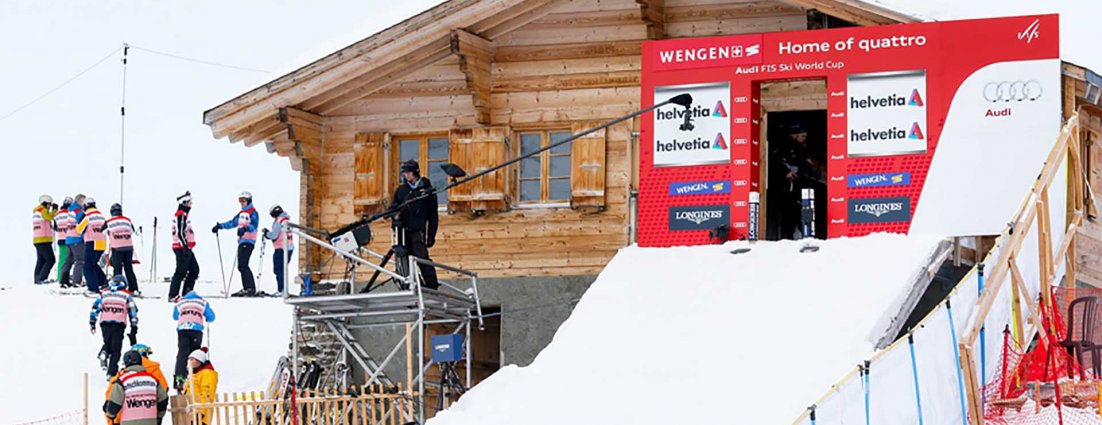Ski Racing Re-Defined
01.25.2017 | Hank Mckee

By Hank Mckee
NASTAR is a platform that allows racers of all age and ability to jump in the gates of a ski course. We understand that our fans come from many different backgrounds. Some are ex-ski racers while for others, it’s their first time in racing gates. We want to make sure you are well versed in technical slang, or even the basic terms of ski racing. From downhill racing to GS and slalom, we’ve got you covered.
Let’s start with the personal equipment. You’ve got skis, of course, and also boots, bindings and poles. Not sticks. Not binders. Not ski shoes. There could also be a binding plate, though these are mostly included in today’s skis that you might buy at a shop. The skis themselves have topsheets, shovels, waists and edges. We rarely talk specifically about those parts, but turn radius certainly peppers many discussions. The turn radius is the arc a ski would carve on its own if the edge was run in the snow without pressure applied. The bottoms of the skis, or bases, get waxed and/or “structured” with a pattern ground into them.
The course itself has a myriad of terms that can be applicable. Expand on that with individual downhill courses which frequently have named turns and sections. For general use you’ve got gates, a finish line and a starthouse with a start wand.
Some starthouses, like the one in Wengen, Switzerland (where World Cup races are held) are quite literally houses. To keep track of all of these parts, a race requires a plethora of officials. A finish referee, a start referee, gate judges and a local chief of race. The TD, or technical delegate, heads up the jury of these officials that will make sure the race follows protocol.
But that’s not all. There are course setters, usually coaches who draw the assignment. And forerunners, normally young racers proficient enough to race, but not good enough to have yet made the list of competitors. Back in the race office are another group of officials doing the calculations, crossing the T’s and dotting the I’s.
In alpine racing there are five disciplines, often listed in the order in which they were conceived: Downhill, slalom, giant slalom, super-G and alpine combined. Straight-up combined, however, was the first Olympic alpine sport, combining a run of downhill and a slalom race to get a winner who was once considered a true master of the sport. Today the alpine combined, altered regularly in the past decade by currently consisting of a single run of speed (either downhill or super-G and a single run of slalom), is the black sheep of the family, attracting calls for discontinuation. Personally, that seems sad.
Slalom has the gates placed the closest together. Slalom skis and also courses are occasionally referred to as “disco sticks.”
The opposite discipline would be downhill with the gates sparsely set over a vertical drop between 500 and 1,000 meters. Of the alpine disciplines, the highest speeds are recorded in downhill. Johan Clarey set the current speed record when he clocked 100.6 mph at Wengen in 2013. It is the premier event of alpine racing, and the one mothers tend to dislike the most. High speeds mean additional danger and more serious injuries.
Giant slalom, or GS, is a two-run race, like slalom, but on a slightly grander scale and using double pole gates with panels.
Super G was devised to give the downhillers more opportunity. It is a single run race with more turns and control gates than downhill, but it is contested with no training runs and just a single inspection. Inspection skills are an oft overlooked but most critical component of any successful ski racer.
Speed skiers race downhill and super-G. Technical skiers race slalom and GS. A rare few very gifted athletes do both, and nowadays we have more hybrid racers who specialize in less traditional combinations like super-G and GS.
Skiers, especially racers, like to play with their equipment. Ski edges get beveled to allow easier turning, and boots or bindings get canted, or have material added to aid in obtaining perfect balance. Some swear by these measures, others suggest they do little, if any, good at all. It’s all a matter of belief.
Racers can drop into a tuck, sometimes called a bullet, to counter air drag. It is generally accepted that a carved turn, without any sideways slide, is the fastest way to progress, although the “stivot” which calls for intentionally pivoting the skis prior to initiating a carve (or a steered-pivot, if you will) has been used successfully on particular turns and in specific course conditions in recent years.
Obviously, there are no simple answers here. There are as many terms and labels as there are skiers. As for our fictitious racer in the first paragraph, they were lamenting sliding into the safety fencing (the red room) after a big right turn (pressure on the left foot) after dropping into a tuck (bullet, or bully). Pretty simple, really. So what’s so confusing?